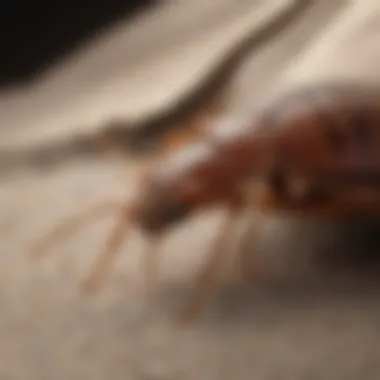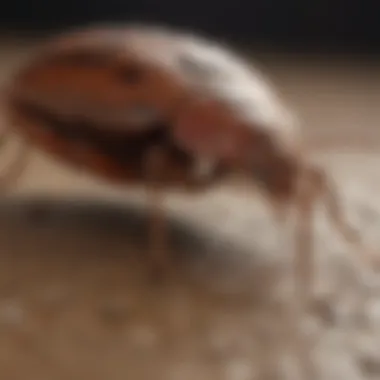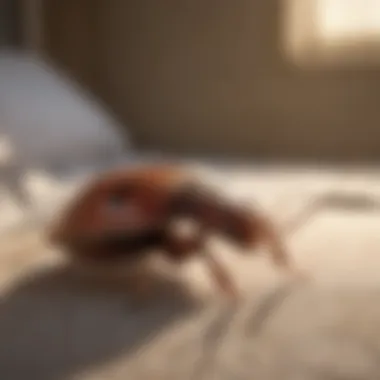A Comprehensive Guide to Eliminating Bed Bugs from Your Home Successfully


Preventive Pest Control Strategies
When it comes to efficient pest control, implementing preventive strategies is crucial. Starting with safeguarding your house's exterior, sealing cracks and crevices is essential in keeping pests at bay. Clearing debris from your surroundings not only enhances the aesthetics but also minimizes hiding spots for pests. Implementing measures to prevent pests from entering your property is a proactive approach to reduce potential infestations.
In addition to safeguarding the exterior, maintaining your yard plays a significant role in pest prevention. Adhering to essential yard care routines such as regular mowing and trimming shrubs can deter pests from nesting. Implementing methods to keep your yard pest-free, like utilizing natural repellents, can further reinforce your pest control efforts.
Indoor cleanliness is paramount in pest prevention. Expert cleaning tips and techniques, such as deep cleaning regularly and proper waste management, are effective in minimizing pest attractions. Creating a pest-resistant indoor environment through proper storage and minimal clutter can significantly reduce the risk of infestations.
Proper garbage disposal is a critical aspect of pest control. Efficient waste disposal methods not only prevent pest attraction but also contribute to a hygienic living space. Emphasizing the importance of proper garbage disposal to all household members is essential in maintaining a pest-free environment.
Beyond the basics, exploring innovative pest prevention strategies can offer an added layer of protection for your home. Implementing unique methods like utilizing natural predators, installing pest barriers, or incorporating technology-driven pest control systems can enhance your defense mechanisms against various pests.
Understanding Bed Bugs
When it comes to eliminating bed bugs from your living space, understanding the enemy is crucial. This section delves into the physical characteristics, habitat, behavior, and signs of bed bug infestation. By comprehensively grasping what bed bugs are and how they operate, you equip yourself with the knowledge necessary for effective eradication strategies.
Physical Characteristics of Bed Bugs
Color and Size
The color and size of bed bugs play a significant role in identifying and dealing with these pests. Adult bed bugs are typically reddish-brown in color, while nymphs are translucent. Measuring about 4-5 mm in length, adult bed bugs are visible to the naked eye. Their small size allows them to hide in cracks and crevices, making detection a challenging task. Understanding these specific physical attributes aids in differentiating bed bugs from other insects and implementing targeted elimination methods effectively.
Distinctive Features
In addition to their coloring and size, bed bugs possess distinctive features that set them apart from other common household pests. One notable characteristic is their flat, oval-shaped bodies, ideal for squeezing into tight spaces like mattress seams and behind baseboards. Their ability to withstand extreme conditions and prolonged periods without feeding contributes to their resilience and infestation potential. Recognizing these distinct features is pivotal in formulating a targeted plan of action to combat bed bug presence.
Habitat and Behavior


Preferred Environments
Bed bugs prefer warm environments close to their hosts, such as humans or pets. They typically reside in areas near sleeping quarters, such as mattresses, box springs, and upholstered furniture. Understanding their affinity for specific habitats helps in narrowing down potential infestation spots and focusing inspection and treatment efforts effectively.
Nocturnal Behavior
Bed bugs exhibit nocturnal behavior, being most active during the night when their hosts are asleep. This behavior pattern not only aids in their feeding habits but also complicates detection during daylight hours. Their secretive nature and preference for darkness emphasize the importance of thorough inspections at varying times to detect and eliminate infestations promptly.
Signs of Bed Bug Infestation
Physical Marks on Skin
One of the telltale signs of a bed bug infestation is the presence of physical marks on the skin. Bed bug bites often result in red, itchy welts, commonly appearing in a linear fashion on exposed areas like arms, legs, and the neck. Recognizing these distinctive bite patterns assists in early detection and prompt action to prevent the infestation from spreading further.
Visible Presence of Bed Bugs
Aside from bites, visually spotting bed bugs or their shed skins is a direct indication of infestation. Adult bed bugs are visible to the naked eye, especially in areas where they aggregate, such as along seams of mattresses or in the crevices of furniture. Identifying these visible signs is essential for confirming an infestation and initiating targeted treatment strategies for effective elimination.
Effective Elimination Methods
In the realm of bed bug elimination, the section on Effective Elimination Methods holds paramount importance within the scope of this article. This pivotal segment encapsulates various strategies and techniques aimed at eradicating bed bugs effectively, providing readers with a comprehensive arsenal to combat this persistent pest. By delving into this section, readers gain profound insights into the nuanced approaches and considerations essential for successful bed bug eradication.
Non-Chemical Approaches
Heat Treatment
Heat treatment is a cornerstone methodology in the spectrum of bed bug eradication strategies. By subjecting affected areas to high temperatures, typically ranging from 120 to 140 degrees Fahrenheit, heat treatment annihilates bed bugs at all life stages, ensuring a thorough elimination process. The key characteristic of heat treatment lies in its non-toxic nature, making it an environmentally friendly and sustainable choice for combatting bed bugs. Additionally, the unique feature of heat treatment is its ability to penetrate deep into crevices and furniture where bed bugs hide, leaving no stone unturned in the eradication process. However, an important consideration with heat treatment is the potential for property damage if not conducted by trained professionals.


Vacuuming and Steaming
Another pivotal aspect of non-chemical bed bug eradication, vacuuming and steaming offer effective solutions to combat infestations. Vacuuming helps physically remove bed bugs, eggs, and nymphs from various surfaces, while steaming provides a lethal blow by exposing bed bugs to high temperatures that are detrimental to their survival. The key characteristic of vacuuming and steaming is their non-invasive nature, making them safe options for use in homes with children or pets. Nevertheless, a challenge associated with these methods is the thoroughness required in covering all infested areas to ensure comprehensive elimination.
Chemical Treatments
Insecticides
Insecticides play a crucial role in the arsenal of chemical treatments for bed bug elimination. These chemical agents target bed bugs directly, disrupting their physiological functions and ultimately leading to their demise. The key characteristic of insecticides lies in their effectiveness in quickly eradicating bed bugs upon contact, providing a swift solution to infestations. However, it is essential to note that prolonged exposure to insecticides can be harmful to humans and pets, emphasizing the importance of following safety guidelines and seeking professional assistance when necessary.
Dusts and Sprays
Dusts and sprays also serve as prominent chemical treatments in the fight against bed bugs. Dust formulations effectively dehydrate bed bugs upon contact, while sprays deliver quick knockdown effects through direct application. The key characteristic of dusts and sprays is their residual efficacy, ensuring continued protection against bed bugs post-treatment. Nevertheless, a consideration with these chemical treatments is the risk of toxicity if not used according to label instructions, highlighting the importance of cautious application and ventilation.
Integrated Pest Management
Combining Strategies
Integrated Pest Management (IPM) emphasizes the integration of various eradication methodologies for a holistic approach to bed bug control. By combining strategies such as non-chemical approaches, chemical treatments, and sanitation practices, IPM offers a comprehensive solution to infestations. The key characteristic of combining strategies lies in its multi-faceted approach, targeting bed bugs through different mechanisms to enhance effectiveness. However, an important consideration with IPM is the coordination and adherence required across all implemented tactics to maximize efficacy.
Long-Term Prevention
A fundamental aspect of IPM, long-term prevention strategies focus on sustainable practices to deter bed bug resurgence. By implementing measures like regular monitoring, sealing cracks, and minimizing clutter, long-term prevention aims to create an inhospitable environment for bed bugs. The key characteristic of long-term prevention is its emphasis on proactive measures to prevent infestations before they occur, promoting a proactive rather than reactive approach to bed bug management. Nevertheless, a consideration with long-term prevention is the diligence and consistency required in upholding preventive practices to ensure continued protection against bed bugs.
Prevention and Maintenance
Prevention and Maintenance play a crucial role in effectively eliminating bed bugs from your home. By implementing proper prevention and maintenance strategies, you can achieve long-term success in keeping these pests at bay. This section will delve into essential elements, benefits, and considerations surrounding prevention and maintenance.


Bed Bug Prevention
Bed bug prevention is key to ensuring your living space remains free from infestations. Taking proactive measures to prevent bed bugs from entering your home is the first line of defense against these stubborn pests. Understanding the importance of travel precautions and regular cleaning practices is paramount for effective prevention.
Travel Precautions
Travel precautions are critical in preventing the introduction of bed bugs into your home. By being vigilant while traveling and inspecting hotel rooms for signs of bed bugs, you can significantly reduce the risk of bringing these pests back with you. The thorough examination of luggage, clothing, and accommodation is a beneficial practice to adopt to safeguard your living environment.
Regular Cleaning Practices
Regular cleaning practices are essential for maintaining a bed bug-free home. Keeping your living space clutter-free, vacuuming regularly, and washing bedding at high temperatures are effective methods for disrupting bed bug infestations. Consistent cleaning not only removes potential hiding spots for bed bugs but also helps in early detection of any signs of infestation.
Sustainable Practices
Incorporating sustainable practices into your bed bug prevention and maintenance routine can lead to long-lasting results. Sustainable practices such as decluttering and sealing cracks and gaps offer environmentally friendly solutions to deter and eliminate bed bugs.
Decluttering
Decluttering your living space is a fundamental step in reducing bed bug hiding spots. By minimizing clutter, you not only make it easier to inspect for bed bugs but also disrupt their preferred environments. Decluttering allows for better airflow and visibility, making it harder for bed bugs to establish themselves in your home.
Sealing Cracks and Gaps
Sealing cracks and gaps in your walls, floors, and furniture prevents bed bugs from finding entry points into your home. By sealing off potential access points, you create a barrier that deters bed bugs from infesting your living space. This sustainable practice helps fortify your home against bed bug intrusions.
Periodic Monitoring
Periodic monitoring is essential for detecting early signs of bed bug infestations and ensuring their prompt elimination. By regularly checking for signs of bed bugs and maintaining vigilance, you can stay ahead of potential infestations and protect your home from these resilient pests.
Checking for Early Signs
Regularly checking for early signs of bed bugs, such as blood spots on bedding or shed exoskeletons, allows for swift action in addressing any infestations. Early detection is key to preventing bed bugs from multiplying and spreading throughout your home. Taking the time to inspect potential hiding spots can help identify bed bug problems before they escalate.
Maintaining Vigilance
Maintaining vigilance involves staying alert to any changes in your living environment that may indicate a bed bug infestation. By remaining vigilant and proactive in your monitoring efforts, you can catch bed bug issues early on and mitigate their impact. Consistent vigilance is a proactive approach to safeguarding your home against bed bugs.



